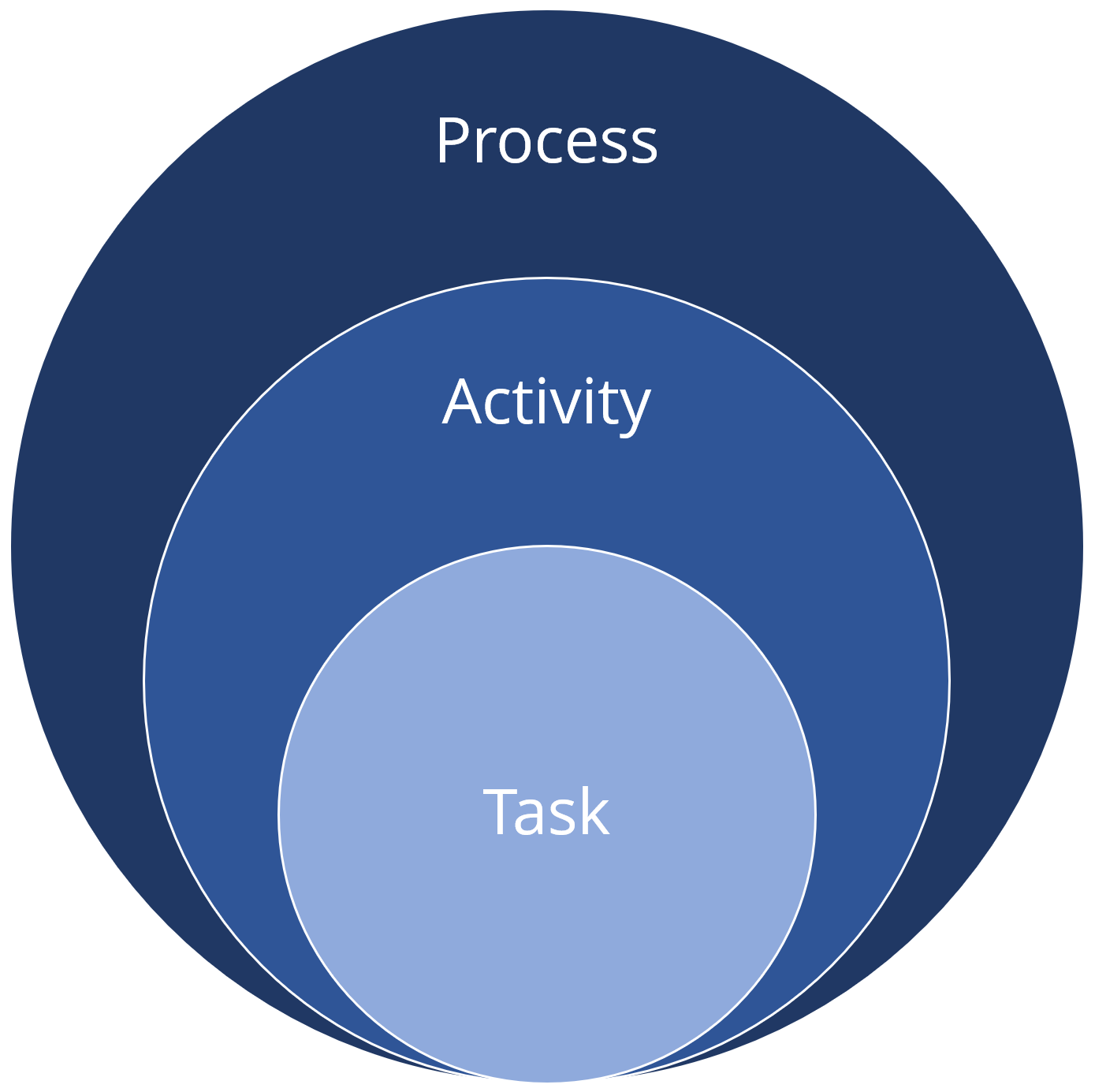What is a task, an activity, a process?

In terms of business management
From the perspective of a business manager, a task, an activity and a process mean specific things, but in every day discussion, they often get mixed up.
When asked what they do at work on a daily basis, the majority of people would be able to describe, fairly easy & pretty accurately, what they do and how they do it.
If you ask them what their tasks or activities are, however, it’s very likely that the answer you’ll get will overlap or that the person you’re asking wouldn’t be able to distinguish between a “task” and an “activity”.
For most people, in conversation and in the back of their mind, the distinction isn’t very relevant, but when the time comes to break down a company’s operations, to really be able to communicate the details and talk about how to improve efficiency, solve issues, or even do something as straight forward as train a new employee, these terms become valuable tools.
Definitions
Processes
Processes are easy to understand as a concept, they are simply the entire set of things a company does to deliver actionable items.
“Invoicing a client” would be a simple example of a process. For the sake of simplicity, most organizations would call it “the invoicing process” and as you can probably guess, it involves all the activities from getting the client’s info, to writing up the invoice with all the details of their order, making sure the client gets it, and collecting the payment.
Activities
Activities, on the other hand, can be hard to pin down. For the purposes of Business Process Improvement, it’s best to think of them as the set of tasks that lead to a milestone in a process.
Following our invoicing example, writing up the actual invoice once we have the details would be a single “activity”, collecting the client’s info would be another, while sending the invoice out would be yet another activity.
Simply put, activities are, well just meaningful things we do.

Tasks
Tasks, we can assume from what has been said so far, are the lowest level of detail. A good way of understanding the concept is to try to think of step-by-step instructions you’d give someone if you wanted them to complete an activity.
Typically tasks make the most sense in context and often make little sense if taken out of context entirely.
From our invoicing example, we said that collecting the client’s info is an activity that is part of the invoicing process, but from the task perspective, it will involve steps: ask the client for their info, enter it into the system, submit it to the client database.
It can be easy to confuse tasks and activities. Continuing with the example, an employee might ask why it matters to think of details such as “entering the client’s info into the system” after you ask them for it. That’s a very good question and for someone who deals with clients, is probably too simple a step to matter, but from the Business Process Improvement perspective, there are many implications.
Case study: Detail-oriented thinking for cost savings
This section is about to get very detailed, so if you just want the core of the info, feel free to skip right down to the next section.
Lets assume for the sake of example that a chain of pizza restaurants, PizzaCo, has a dozen locations and offers pizza delivery all over the city.
Each of PizzaCo’s locations have two people taking orders for delivery earning 15$/hour.
If it takes an employee on average 2 minutes to take down the client’s address and info and validate it, most managers would be tempted to think it’s just a normal task, part of the employee’s activities, hardly worth worrying about.
However at scale, the implications are quite significant.
Imagine a single PizzaCo location handles a dozen calls per hour, of which 2 minutes are spent getting the client’s info.
That means that each location spends 24 minutes per hour on this task, which realistically costs them 6$ per hour on average. Assuming that this volume of calls comes in for 8 hours out of the day, the unimpressive 6$ per hour comes up to a slightly more noticeable 240$ per week.
It’s likely that only the most meticulous and detail oriented store managers would dig into this level of detail for such a small amount.
The regional manager, however, would probably do well to know that number. From the regional manager’s perspective, that cost of 240$ per week can be multiplied by the number of weeks in a year and the number of locations they manage, which in reality would add up to a staggering 149,760$ per year spent asking clients for their address.
A sharp regional manger might pitch the idea to set up a software system that grabs the phone number calling in to place an order and checks whether or not the address is already on file — that way the price tag of 149,760$ per year can be cut significantly.
In an example like ours, seeing a cost savings and efficiency gain of 50% or more is common.
Most organizations have many similar situations: a simple task (such as taking down client info), part of normal, every day activity (such as taking orders), seems like too small a part of the process (such as selling pizzas) to have a meaningful impact but is in fact costing a considerable amount of money because of inefficiencies so natural that few would think to get rid of them.
How can a consultant help?
No matter how strong the management team, as a business grows, the amount of tasks, activities and processes that are carried out every day eventually grows to the point where no single person can keep all the details in mind.
When looking for opportunities to improve, or facing challenges growing, taking the time to map out all the processes, the activities they involve and the tasks they entail can make the difference between a breakout success, and a failed project.
Professional management consultants are specifically trained to investigate all relevant levels of information, to truly understand, define and communicate exactly what is going on in the business’s day to day operations.
With this information in hand, with clearly documented and mapped out processes, any organization can find opportunities to improve and upgrade.
When the management team is focusing on keeping operations smooth and revenues high, their attention may be too valuable to investigate all these details themselves.
No matter how mature an organization is, they can always benefit from a management consultant to investigate, document and recommend the best ways to excel.
